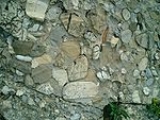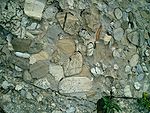
Molasse
Encyclopedia

Shalës
Shalës is a municipality in the Elbasan District, Elbasan County, central Albania. The municipality consists of the villages Shalës, Licaj, Kurtalli, Xibrake, Xherie and Kodras....
and conglomerate
Conglomerate (geology)
A conglomerate is a rock consisting of individual clasts within a finer-grained matrix that have become cemented together. Conglomerates are sedimentary rocks consisting of rounded fragments and are thus differentiated from breccias, which consist of angular clasts...
s formed as terrestrial or shallow marine
Marine (ocean)
Marine is an umbrella term. As an adjective it is usually applicable to things relating to the sea or ocean, such as marine biology, marine ecology and marine geology...
deposits in front of rising mountain chains. The molasse is deposited in a foreland basin
Foreland basin
A foreland basin is a depression that develops adjacent and parallel to a mountain belt. Foreland basins form because the immense mass created by crustal thickening associated with the evolution of a mountain belt causes the lithosphere to bend, by a process known as lithospheric flexure...
, especially on top of flysch
Flysch
Flysch is a sequence of sedimentary rocks that is deposited in a deep marine facies in the foreland basin of a developing orogen. Flysch is typically deposited during an early stage of the orogenesis. When the orogen evolves the foreland basin becomes shallower and molasse is deposited on top of...
, for example that left from the rising Alps
Alps
The Alps is one of the great mountain range systems of Europe, stretching from Austria and Slovenia in the east through Italy, Switzerland, Liechtenstein and Germany to France in the west....
, or erosion in the Himalaya. These deposits are typically the non-marine alluvial and fluvial
Fluvial
Fluvial is used in geography and Earth science to refer to the processes associated with rivers and streams and the deposits and landforms created by them...
sediments of lowlands, as compared to deep-water flysch sediments. Sedimentation stops once the orogeny
Orogeny
Orogeny refers to forces and events leading to a severe structural deformation of the Earth's crust due to the engagement of tectonic plates. Response to such engagement results in the formation of long tracts of highly deformed rock called orogens or orogenic belts...
stops, or once the mountains have eroded flat.
The molasse can sometimes completely fill a foreland basin, creating a nearly flat depositional surface, that nonetheless remains a structural syncline
Syncline
In structural geology, a syncline is a fold, with younger layers closer to the center of the structure. A synclinorium is a large syncline with superimposed smaller folds. Synclines are typically a downward fold, termed a synformal syncline In structural geology, a syncline is a fold, with younger...
. Molasse can be very thick near the mountain front, but usually thins out towards the interior of a craton
Craton
A craton is an old and stable part of the continental lithosphere. Having often survived cycles of merging and rifting of continents, cratons are generally found in the interiors of tectonic plates. They are characteristically composed of ancient crystalline basement rock, which may be covered by...
; such massive, convex accumulations of sediment are known as clastic wedge
Clastic wedge
In geology, clastic wedge usually refers to a thick assemblage of sediments--often lens-shaped in profile--eroded and deposited landward of a mountain chain; they begin at the mountain front, thicken considerably landwards of it to a peak depth, and progressively thin with increasing distance inland...
s.
External links
- http://earth.leeds.ac.uk/alps/map/molasse.htm Molasse, definitions and examples, simplified geological map of the western Alps. University of Leeds

